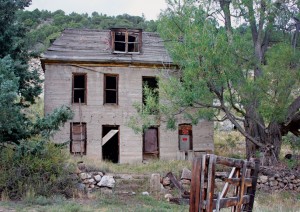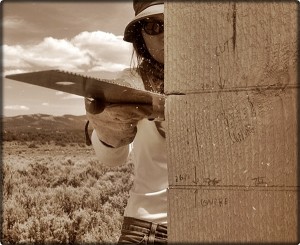by John Orr
Colorado River Basin: Colorado College State of the Rockies Project
“For some reason we’re starting this in October,” quips Will Stauffer-Norris, standing in cold weather gear and snowshoes, down valley from the headwaters of the Green River. He made the statement in the first video chronicling his journey – along with fellow traveler Zak Podmore – from Source to Sea. They’re heading down the Green River to the confluence with the Colorado River and then down the Colorado to the delta, where the river used to meet to the Pacific Ocean, as recently as the 1990s.
Will and Zak are running and paddling the rivers as their part of the student/faculty effort for this year’s State of the Rockies Project at Colorado College. The theme for this year is The Colorado River Basin: Agenda for Use, Restoration, and Sustainability for the Next Generation. The project – in its eighth year now – is asking the students to chart a vision for how the next generation wants the Colorado River to appear in the future.
All Coloradans have a stake in the Colorado River Basin. There is a projected water supply gap in Colorado of 500,000 acre-feet in the year 2050, and transmountain water is a major component of supply for Front Range farms and cities. Projects are being discussed that would divert more West Slope water over the hill.
The river basins in Central Colorado are joined to the Colorado River Basin by transbasin diversions, ditches, water tunnels, pump works, and the need to water the population growth, energy production/generation and irrigation needs of the Front Range and points south on the eastern plains.
I’m grateful to the The Pueblo Chieftain, the Blue River Watershed Group, the Office of the State Engineer and the United States Geological Survey for the following information about transbasin diversions into Central Colorado.
Diversions to the Arkansas River Basin include:
• The Boustead Tunnel moves water from the Fryingpan River watershed to the Arkansas Basin and Turquoise Lake near Leadville. In addition to the fishery at Turquoise, releases from the reservoir account for some of the flows that the whitewater industry in the Upper Arkansas Valley depends on to fuel economic activity. Those flows are stored in Lake Pueblo, built as part of the Fryingpan-Arkansas Project, for irrigators and municipalities.
• The Busk-Ivanhoe Tunnel was first a railroad tunnel, then an automobile tunnel. It is owned by Pueblo and Aurora, and releases water into the watershed above Turquoise Lake.
• The Twin Lakes Tunnel, near Independence Pass, was built by Crowley County irrigators but is now owned by Colorado Springs, Pueblo, Pueblo West and Aurora. The Twin Lakes were enlarged twice, once by the Colorado Canal Company and once by the U.S. Bureau of Reclamation as part of the Fryingpan-Arkansas Project.
• In the 1950s Aurora and Colorado Springs started building the Homestake Project, utilizing the Homestake Tunnel to bring water into the Arkansas Basin from the Eagle River watershed. The water is then pumped from the Arkansas Basin to the South Platte River Basin at the Otero Pump station near Buena Vista.
The Arkansas River basin is also home to numerous ditches that move water to the basin.
• The Warren E. Wurtz Ditch (1929) which brings water over from the Eagle River Basin north of Leadville, is owned by the Pueblo Board of Water Works.
• The Ewing Ditch (1880) – one of the oldest transbasin diversions in Colorado – was purchased by the Pueblo Board of Water Works from the Otero Canal Company in 1954. It diverts from the Eagle River watershed.
• The Larkspur Ditch diverts from the Gunnison River Basin and is owned by the Lower Arkansas Valley Water Conservancy District.
• The Hudson Branch and Medano ditches divert from the Rio Grande River Basin.
• The Columbine Ditch, now owned jointly by Aurora and Climax Molybdenum, diverts from the Eagle River watershed to the South Platte River Basin.
The Upper South Platte River Basin helps to water the Front Range, including much of the Metropolitan Denver area. Diversions of interest to Central Colorado are:
• The Harold D. Roberts Tunnel, diverting from the Blue River watershed to the North Fork of the South Platte river upstream of Bailey, is owned by Denver Water.
• The Hoosier Pass Tunnel, also diverting from the Blue River watershed, is owned by Colorado Springs and diverts into the South Platte River.
• The Boreas Pass Ditch, another diversion from the Blue River watershed, diverts into North Taryall Creek and is owned by the City of Englewood.
The Rio Grande River Basin imports water from the San Juan River and Gunnison River basins, primarily for irrigation. Rio Grande Basin diversions from the Gunnison River Basin include the Tarbell Ditch and Tabor Ditch No. 2. Diversions from the San Juan River Basin include the Weminuche Pass Ditch, the Pine River Ditch – Weminuche Pass Ditch, the Williams Squaw Pass Ditch, Don La Font Ditches 1 and 2 and the Treasure Pass Diversion Ditch.
Colorado also depends on the Colorado River for winter vegetables from the Imperial Valley in California. Another water import from west to east is in the form of beef fattened up on hay and alfalfa from the irrigated fields in the Colorado River Basin.
Most high mountain ditch flows diminish greatly late in the summer so storage is important. Mainstem storage, however, damages the river system, affecting flow rates and flattening the hydrograph.
The interconnectedness of the basins makes it everyone’s job to keep an eye on things.
Climate change is expected to lead to a diminished snowpack that runs off more quickly a bit earlier each year. More change of use applications involving agricultural water to municipal use transfers are on the horizon. Oil shale – the next big thing for over a hundred years now – could be a heavy user. Geothermal development is imminent in the Upper Arkansas Valley.
I don’t know if Will and Zak are thinking about these things as they paddle down the massive plumbing system in the Colorado River Basin. I do know that they are seeing a far different view from John Wesley Powell’s first trip down the river from Green River, Wyoming in 1869. Wish them luck.
For further reading about the State of the Rockies Project and the Colorado River Basin please visit: www2.coloradocollege.edu/stateoftherockies
Short Takes
• Make sure to visit the Colorado Water 2012 website (water2012.org) for the latest news on the statewide celebration starting this month.
• Back in October Nestlé Waters North America was gearing up to apply for permit for construction in a wetland environment from the Corps of Engineers to tear out the old Hagen fish hatchery at the Ruby Mountain Spring near Nathrop. Restoration of the area is a condition of their permit with Chaffee County.
• The Ruby Range made the Colorado Geological Survey’s list of eleven, “headwater areas where surface water is acidic and has high concentrations of metals such as aluminum, manganese and iron, even upstream of any significant human impacts,” according to The Denver Post. Mount Emmons is located in the Ruby Range, near Crested Butte. US Energy is hoping to set up exploration there but the High County Citizens Alliance has filed a lawsuit against the state over the permit. g
John Orr follows Colorado Water issues at Coyote Gulch. www.coyotegulch.net



